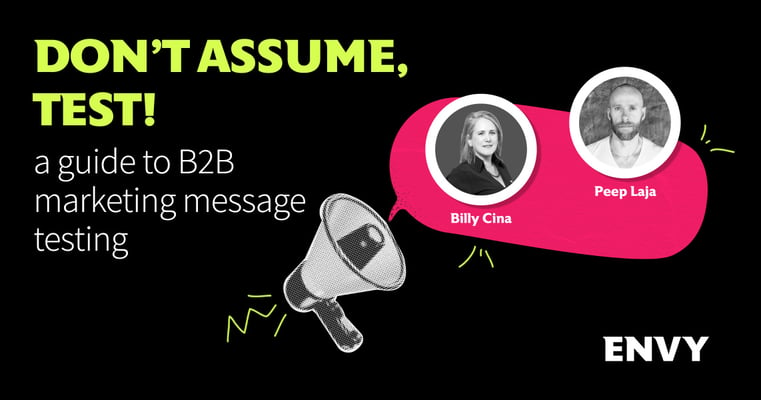
NOT testing your B2B messaging is costing you $$$
Message testing sounds straightforward and appealing enough. Who doesn’t want to know if their messaging actually resonates before going live?! But when it comes to taking the extra step (and budget) to actually test it, we often hear hesitation.
“Let’s just launch the campaign and see what happens”, we’ve heard that too many times. And then what happens? Well, if you’re lucky, some conversions will take place. But in most cases, it’s a whole lot of wasted ad spend. If your team has ever jumped straight to launch (and we know you have), crossing fingers that the message lands, this one’s for you.
You’ve heard me talk about Wynter before. This time, I spoke with no other than Peep Laja, CEO of Wynter himself. Because message testing shouldn’t be some fancy extra step—it’s one of the smartest ways to optimize without breaking the bank.
If you want a TL;DR, you can just watch the conversation here:
Why do so many companies skip message testing?
First things first, let’s start by calling out the main reasons message testing gets pushed to the sidelines–and then prove why they’re wrong 😉
- There’s pressure to launch now: I know. Marketers are constantly juggling big growth goals with tight timelines. It makes sense that message testing feels like a “nice-to-have” when everyone’s screaming for results yesterday.
- Some believe in “real-world testing”: What’s the point in spending more when you’ll get the same insights just by launching and adjusting based on results?
- Messaging committee’s trust: A lot of teams rely on internal feedback, assuming it’s “good enough.” Spoiler: it’s not. Your internal team isn’t your target audience, and what sounds clear to you might be falling flat for the people you actually want to convert.
Here’s the thing: if you’re not testing your messaging before launch, you’re taking a gamble on your campaign budget and ROI. But how to explain that to the leadership team?
Why the “launch and see” method is too costly
Launching a campaign without testing is essentially shouting into the void. You’re putting your message out there, hoping it sticks, without any indication of how it’s received. Sure, the real world provides feedback eventually, but by then, it’s too late to pivot without a lot of rework, time & cost sacrifices, and–even then–lots of guesses.
When you launch a campaign and the conversion rate hurts your eyes (and soul), what do you optimize? Landing page? Ad copy? Targeting? Offering? Pricing? All at once? Or none at all, and just kill the campaign instead?
Take Envy, for example. A few months ago we were working on refreshing our home page. It took us a good while to come up with a strong headline we all resonated with, fabulous Didi polished the page, and we were just hitting the “Publish” button before I figured… hold on, let’s test it first.
I’ve talked about it here in more detail and am happy to share the exact results, but what our target audience said essentially moved us back to square one:
- The person on the photo doesn’t look like our team, doesn’t look like our target audience. Why did we even choose him?
- Why do we need four messages, all going in different directions, one after another? We didn’t notice that before the test.
- Difficult to read, off-puting colors or fonts (and these are incredibly easy to fix, mind you). We had no idea. It was news to us!
- We’re giving… bro vibes??? No thank you. So unintentional and not our style.
And below we’re answering to the other common reasons to skip message testing:
- It takes time to test? Sure, it takes 24-28 hours to get results. How long did it take you to write that copy, get the creative done and run it through all departments? How many iterations? How many weeks did the copy just sit there in the doc?
- Wanna launch and see? Go ahead. But testing your landing page with your actual target audience gives you clear instructions when it comes to optimizing: what resonates, what doesn’t, what do we do with this.
- Message testing gives the WHY the copy and design doesn’t resonate. Real folks, your ICP tell you what they did and did not like and why. Pure testing on paid channels will only provide insights into the WHAT converts, not the rationale.
- You think you know what you’re saying? Think again. With messaging committees of more than 3, and legal involved, your message gets dissolved before you blink twice.
Messaging that stands out or blends in
Unless you’re already a market leader, your messaging cannot be bland. When you’re an international giant, you can afford to be lazy with your messaging as your budget and brand cover the sloppy messaging.
But for the tech companies we usually work with, say cybersecurity or SaaS, where you deal with 3,000+ competitors daily and everyone is saying the same thing.
Peep pointed out that the research process for many prospects looks like this: people are looking at the international giant within your industry, comparing it against maybe one or two companies interesting enough to stand out. That’s it. That’s your only chance. Only some will go through all their options thoroughly, so you only have a few seconds for your message to hit home.
And that’s where message testing helps you win:
- Dial in your differentiators and focus on your unique angle.
- Get rid of fluff and hone in on language that speaks directly to pain points.
- Optimize for clarity and relevance so your value proposition is instantly clear.
Without testing, it’s easy to go live with messaging that sounds just like everyone else’s—and ends up costing you more in wasted ad spend and missed conversions.
A/B testing or message testing?
We’re already A/B testing our messages, now we need to add more testing??
It all depends–on your budget, time restraints and goals.
B2B ad budgets aren’t cheap–yet so many companies are happy to pour more money into A/B testing on paid channels, hoping to discover the winning message. Don’t get me wrong, I’m not saying A/B testing is off the table. A/B testing remains critical for fine-tuning messaging and honing in on the highest-performing versions. But without message testing before A/B testing, you’re working with a rough draft instead of a refined message. Is version B different enough from version A to tell you what’s working and what isn’t, or is it just a minute detail the team couldn’t agree on? Message testing lets you eliminate those big issues early, making your A/B tests more productive and strategic.
How to sell message testing internally
If you’re reading this because you’re not convinced as to how effective message testing can be, here’s a dealbreaker. If you’re here because you’re like me and you love Wynter to bits but the rest of your team isn’t on board with message testing–again, here’s a dealbreaker.
If you’re launching your campaigns without testing the messaging first, you’re essentially pitching your product on a demo call, but your prospect’s camera and mic are off. You can’t see their reactions, you can’t hear what they think. You can only guess–that’s how Peep explained it and it honestly doesn’t get clearer than this.
Message testing costs ~$2500.
Deduct that from month one’s paid campaigns. That’s it.
Don’t assume, test
At Envy, we don’t believe in quick wins–but message testing is exactly that. It lets you skip the guesswork, minimize campaign risk, and maximize your ROI with messaging that’s built to convert from day one. When you think about it, it’s a small upfront cost that pays dividends in performance—think of it as a tiny investment that amplifies every campaign dollar.
We could go on, but you get the point. And you know where to reach us if you need a hand.





.jpg?width=352&name=The%20Envy%20Way%20of%20Auditing%20Google%20Search%20Campaigns_%20Checklist%20(3).jpg)

